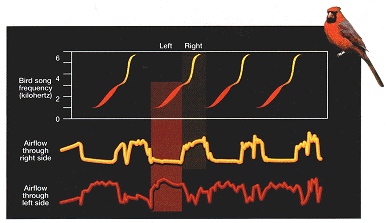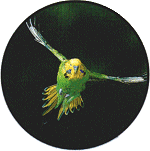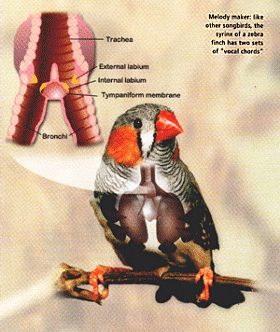Virtuoso performance
Is it a whistle, is it a flute, is it a kazoo? The instrument
that shapes the glorious music of songbirds has remained a mystery... until
now. Bob Holmes reports
THE SCENE: Dawn in a sun-kissed country garden. A soft breeze
stirs the dew on the rose petals. As the first light washes over the eastern
horizon, hundreds of birds strike up a chorus, their tiny bodies filling
the air with fortissimo melodies.
Cut! This is a science magazine, not an over-the-top travelogue, and we need
go no further than those warbling warblers to find a research question worth
pondering, namely, how do those little birds produce such big, beautiful
songs? What instrument can craft such music? You'd think scientists would
have figured that out long ago. But as recently as a decade ago, biologists
could offer little more than guesses about what goes on in a bird's throat
as it shapes its song.
But over the past few years researchers have enticed birds to sing with
fibreoptic scopes down their throats, with their beaks immobilised and even
in a helium-oxygen atmosphere. They have measured birds' breathing and the
activity of their throat muscles during song. And they have shown how one
group of birds, the songbirds, exploits a feature that human singers can
only dream about-two voice boxes, which means that a bird can do two
different things at once with its throat, even sing a duet with itself.
"It's a very versatile instrument," says Jeffrey Podos, an evolutionary
behaviourist at the University of Arizona in Tucson. "Songbirds hit on something
big about 60 million years ago when they first evolved." But even today,
the experts can't answer some basic questions, such as how birds can sing
so loudly.
To understand why progress has been so slow, you have only to look for a
bird's syrinx, its vocal organ. Unlike the larynx of mammals, which sits
in the neck where researchers can reach it easily, the syrinx is buried deep
in the body. Birds do not breathe like mammals, but have air sacs that act
like bellows, pumping air through the lungs. Enclosed by one of these sacs,
bound in a tangle of muscle near the heart, is the nut-shaped syrinx. For
a thrush, it's about the size of a baby pea.
In ducks, chickens, parrots and other relatively primitive birds, the syrinx
sits in the windpipe just above where it branches into the bronchi that serve
the two lungs. But in songbirds such as warblers, larks and sparrows you'll
see a double structure that sits a little lower still, with one part in each
of the two bronchi (see Diagram, above).
The problem for avian anatomists is that its position makes the syrinx virtually
impossible to watch in action. For decades, researchers had to make do with
indirect approaches such as cutting this or that muscle and waiting to see
what effect this had on the bird's song.
Duet for one
But in 1990 Roderick Suthers, a physiologist at Indiana University in
Bloomington, hit on a novel approach. He surgically implanted tiny devices
to measure airflow in the bronchi of two species of North American songbirds,
the grey catbird and the brown thrasher. When the birds resumed singing a
few days later, he could tell exactly which notes came from each of their
two voices.
Since then, similar experiments by Suthers and his colleagues have shown
that the paired syrinx gives songbirds a varied bag of tricks for building
complex songs. Some birds, such as the thrasher, sing a true duet in which
both voices sound at the same time to add harmonic complexity. One side might
sing a rising note while the other sings a falling note, for example. Others,
such as the brown cowbird, sing rapid-fire bursts in which the two sides
alternate notes, a strategy that may give each side time to prepare its next
note without ragged transitions.
In many birds, the two sides act like the woofer and tweeter of a loudspeaker,
with the left side specialising in lower notes and the right side in higher
ones. One virtuoso performer, the cardinal sings a note that sweeps smoothly
upward from about 1 kilohertz to 7 kilohertz, like the first note in a wolf
whistle. At about 3.5 kilohertz, the sound switches seamlessly from left
to right (see Diagram,below ). Unlike speakers, however, a songbird's woofer
and tweeter don't differ much in size or construction. "You don't see obvious
differences, but that doesn't mean there aren't some subtle ones," says Suthers.
Much of the specialisation could be accounted for by differences in muscular
force applied to the two sides, he speculates.
 |
| Woofer and tweeter: the cardinal sings a low, rising note through the left side of its syrinx before switching seamlessly to the right side |
Canaries use their double syrinx in yet another way. Suthers found that they
sing through the left side and inhale through the right. Such a strategy
is possible because bird lungs interconnect so that a one-sided inhalation
can fill both lungs. This division of labour, Suther reckons, may help the
birds to dash off long runs containing as many as 30 "syllables", or short
sound segments, per second. To avoid running out of air, Suthers has found,
singing canaries sneak a quick breath after every syllable.
Speed, it seems, may be of the essence. One recent study found that female
canaries prefer males with faster songs. Males of other species may feel
similar pressure, says Podos. He tried to get swamp sparrows to sing faster
by taping wild songs and editing out the natural breaths between syllables.
He then used these breathless songs-which sounded like the avian equivalent
of "fine print" in radio adverts-to teach young swamp sparrows that had never
heard a normal song. The birds did their best to copy, but couldn't keep
up for more than a few syllables before stopping as if to catch their breath.
"Even a relatively minor increase in trill rate seems to cause a backlash
in performance," says Podos. "That suggests that songs in the wild might
already be at the edge of what males can do.
'A zebra finch's song has points where the sound changes abruptly from a pure tone to a buzz: a hallmark of a system on the edge of chaos'
" Even as researchers began to understand how songbirds use
the two halves of their syrinx, though, they remained unsure of how either
actually produced its sound. For years, they guessed that birds either whistled
like a kettle by forcing air through a narrow passage in the syrinx, or buzzed
like a kazoo by vibrating the thin tympaniform membrane that lies flat against
the side of each air passage. Then, two years ago, Franz Goller of the University
of Utah in Salt Lake City and Ole Larsen of Odense University in Denmark
managed to feed a spaghetti-like fibreoptic scope down a songbird's windpipe
and watch its syrinx as it sang. "We had always felt that if anybody could
find a way to do that and still get the bird to sing-which blows my mind-that
was the way to handle it. And he did," says Abbot Gaunt a morphologist now
retired, from Ohio State University, who proposed the whistle hypothesis
many years ago.
To their surprise, Goller and Larsen saw that the syrinx works not like a
kazoo or whistle, but much like the human voice. During song, muscles pull
two heavy folds of tissue- the internal and external labia -into the airway.
Here, outrushing air sets them vibrating, just as happens with human vocal
cords. The kazoo-like membrane doesn't affect sound much at all-when they
destroyed it surgically, pitch and volume changed only slightly.
From birds to humans
Still, doubt remain. Goller and Larsen lacked a stroboscopic camera to see
the heavy folds vibrating during the song. And in a later study that did
use such a camera, Michale Fee of Lucent Technologies' Bell Laboratories
in Murray Hill, New Jersey, saw only one of the two labia vibrating, along
with the kazoo-like membrane. Fee, however, did not study live birds but
the excised syrinx of a zebra finch, which lacked normal muscle tension.
Though this debate may seem academic, says Fee, there's actually more at
stake than that. "I think that by studying the syrinx we can learn something
about how the human vocal apparatus works," he says. Efforts to mimic human
speech with technology have not worked well, he argues. This is due, at least
in part to our lack of understanding of how vocal apparatus works.
Fee and his colleagues also found an intriguing hint that the syrinx may
run on autopilot for at least part of a bird's song. A live zebra finch's
song includes points at which the sound changes abruptly from a pure tone
to a noisy buzz and back again-a hallmark of a system
on the edge of chaos. Fee's excised syrinx exhibited the same sudden
transitions as he forced air through it at gradually increasing speeds. This
suggested that simple changes in airflow, not delicate orchestration by the
brain, may account for some of the richness of zebra finch song. "There's
a lot of structure in the song that seems to be easily explained by the mechanics
of the syrinx rather than by direct neural control" says Fee.
If the syrinx is like the mouthpiece of a trumpet a bird's throat and mouth
play the parts of the tubing, valves and bell. Resonances here modify the
original sound enormously as it passes through. The effect is easy to hear
in humans, where the throat, mouth and lips form all the various vowel and
consonant sounds of speech, as well as many of the differences in timbre
that make every person's voice unique.
It also explains why someone who talks after breathing in helium sounds like
a munchkin. Less dense than air, helium conducts sound faster and emphasises
resonances in the vocal tract at pitches that are higher than normal even
though the frequency of vibration of the vocal cords changes very little.
Something similar, though less dramatic, happens with birds. More than a
decade ago,
ethologist
Stephen Nowicki, who is now at Duke University in Durham, North Carolina,
immersed members of nine songbird species in a helium-rich atmosphere and
recorded their songs. In every case, he recorded high-frequency overtones-which
led to a squeakier sound-that were absent when the birds sang in air. This
led him to suggest that the upper vocal tract acts as a
filter, helping to produce relatively pure
tones by amplifying some pitches generated by the syrinx and not others.
But since many birds' songs leap about from octave to octave, they must
constantly adjust the filter to let the right
pitches through. When Nowicki and his colleagues filmed sparrows singing,
they found that the birds opened their beaks wider for high notes, thus
shortening their vocal tract and making it resonate at a higher frequency.
In a later experiment which has yet to be published, researchers in Nowicki's
lab immobilised sparrows' beaks at a fixed gape by clamping them for brief
periods to a "bite block". "After several days of training, you do get the
birds to actually sing with their beaks clamped," says Podos, who was then
Nowicki's student. Sure enough, those birds sing squeakier songs with more
overtones.
As you might expect, the complex coordination needed to conduct syrinx, throat
and beak takes practice. "It's like a musician
becoming proficient at playing a song," says Podos. "A trumpeter has to learn
to match what they're doing with their hands with what they're doing with
their lips." Indeed, he found that when young sparrows are learning to sing,
they start by getting the rhythm and pitch of the
notes right. One of the last things they learn is how to adapt their whole
vocal tract to sing pure tones. So the next time you find yourself in that
country garden at dawn, listen more closely to the chorus and see if you
can sort the seasoned pros from the beginners.
| WHO'S A PRETTY BOY? |
 TALKING parrots have fascinated people
for centuries, but only in recent years have scientists figured out out some
of Polly's tricks. Both parrots and their smaller cousins the budgerigars
mimic speech by copying the changing patterns of frequencies that give each
vowel and consonant its sound. But they do it in totally different ways. TALKING parrots have fascinated people
for centuries, but only in recent years have scientists figured out out some
of Polly's tricks. Both parrots and their smaller cousins the budgerigars
mimic speech by copying the changing patterns of frequencies that give each
vowel and consonant its sound. But they do it in totally different ways.Ethologist lrene Pepperberg and her colleagues at the university of Arizona in Tucson watched with infrared and X-ray cameras as Alex, a trained African grey parrot, spoke a variety of English words. Alex uses the same basic strategy as humans, they, found. He creates a vibration with his syrinx (we use our voicebox), then uses his throat, mouth and tongue to alter the dominant frequencies, or "formants", to give the sound he wants. For example, Alex opens his beak wider for an "en" then for an "ah", and probably pushes his tongue further forward as well. But Alex lacks lips and teeth, which are critical in forming human consonants. "He has to work harder to come up with a strategy for consonants" says Pepperberg. She still does not know exactly how Alex does it, but some evidence suggests he uses his oesophagus. In making a "b" sound. Just as a small flute can't sound a very low note, so smaller birds such as budgies have trouble producing the deep pitches in human speech. "The budgie has a size problem," says Pamela Banta Lavenex, a former student of Pepperberg's who is now at the University of California, Davis, "if they want to be heard, they're much better to go to a higher frequency where they  can
be louder." can
be louder."To do this, Santa Lavenex found, budgies use amplitude modulation, the principle behind AM radio. With their syrinx, they generate a "carrier frequency" sound between 2 and 3 kilohertz. Then they produce a second vibration - Banta Lavenex is still not sure exactly where, but probably also in the syrinx-that modifies the carrier. As these two sounds add and subtract, they produce additional frequencies. Just where the formants are for human speech. |
